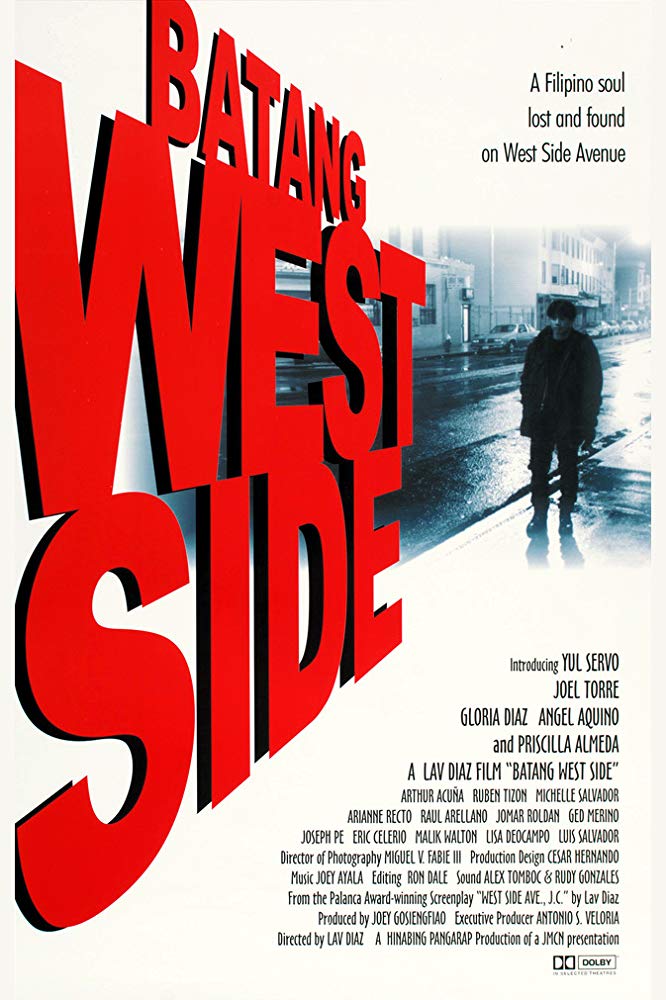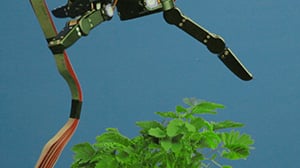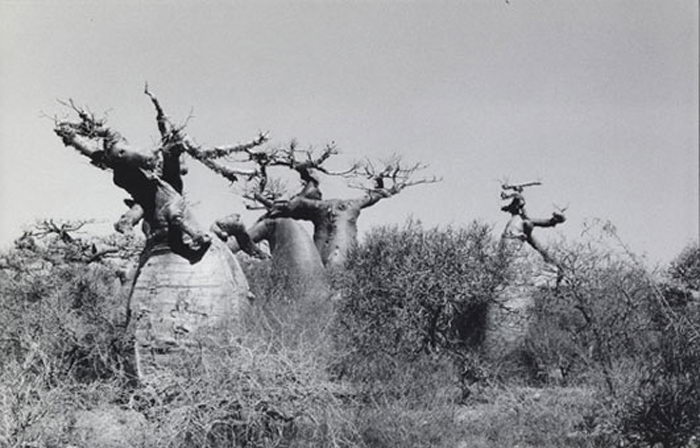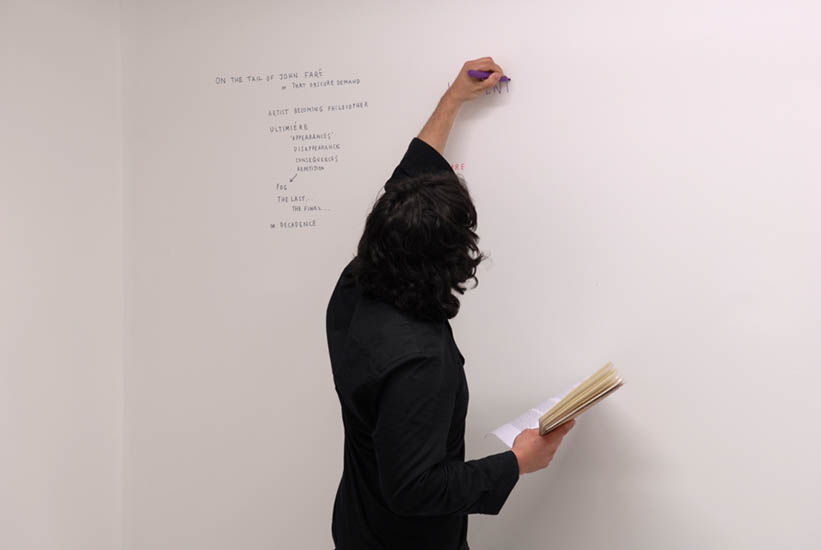
© » KADIST
Som Supaparinya
When Need Moves the Earth is a three-channel video that combines elements of documentary footage, archival material and abstract aerial shots to encompass a painterly yet forthright exploration of a coal mine and a water dam in Thailand. A meditation on the impact of industrialization on the natural environment, the work highlights the drastic alterations that these operations leave in its place. Som Supaparinya’s work is often a commentary on political, social, and personal issues.

© » KADIST
John Morris
Drawing & Print (Drawing & Print)
Untitled was part of the 2002 exhibition “Drawings for the Austrian School” held at the D’Amelio Terras gallery in New York. For this occasion, Morris created a language of his own by using acrylic, ink, graphite and ballpoint pen on paper. The exhibition title comes from Morris’ interest in the early 20th century Austrian economist Joseph Schumpeter, a one time Austrian Minister of Finance, bank director, and economics professor who taught in Europe and at Harvard University.

© » KADIST
Randa Maddah
A woman meticulously tidies up the room of a ruined house in the village of Ain Fit in the occupied Syrian Golan. The village was destroyed by the Israeli forces in 1967, as was the case for many other villages. Inhabitants were prevented from returning to their homes, fleeing to Syria’s refugee camps, separated from the rest of their families.

© » KADIST
Aubrey Williams
Carib Carnival illustrates Aubrey Willams’s unique artistic language, combining Pre-Columbian iconography with abstraction. A series of abstracted shapes that resemble bones, masks and serpent-like images surrounded by fiery vapors and gases, illustrate the destruction of culture as one of the predominant themes of Williams’s work. He considered the Mayan and Aztec cultures to exemplify a number of present-day faults; according to Williams they developed technologies that would eventually lead to their own destruction.

© » KADIST
Rodrigo Braga
Braga’s video work Provisão (2009) opens with a still shot of a clearing in a forest, shoots of grass emerging from a muddy brown patch of seemingly dry and barren earth. As the camera fades to black, the viewer hears the repeated sound of a shovel striking dirt. The camera fades back to the clearing and zooms in on a shirtless man digging up the ground.

© » KADIST
Walid Raad
Drawing & Print (Drawing & Print)
“The Lebanese wars of the past three decades affected Lebanon’s residents physically and psychologically: from the hundred thousand plus who were killed; to the two hundred thousand plus who were wounded; to the million plus who were displaced; to the even more who were psychologically traumatized. Needless to say, the wars also affected Lebanese cities, buildings and institutions. It is clear to me today that these wars also affected colours, lines, shapes and forms.

© » KADIST
Naoya Hatakeyama
Naoya Hatakeyama’s series Rikuzentakata (2011) documents the devastating aftermath of the 2011 Tohoku earthquake and tsunami in Japan. Throughout the series of sixty C-prints, Hatakeyama’s photographs depict scenes of torn landscapes and leveled homes, demolished villages and massive piles of detritus pummeled beyond recognition. The images serve as records of disaster, seemingly driven by an intense need to bear witness to collective trauma.

© » KADIST
Walead Beshty
Office Work by Walead Beshty consists of a partially deconstructed desktop monitor screen, cleanly speared through its center onto a metal pole. Despite its dismantled form, the screen still functions, a simple, mountain-range desktop background clearly visible with no distortion. As with much of Beshty’s work, Office Work thematizes its own construction, in this case, through a clearly deconstructive action that preserves the technological ontology present through the monitor.

© » KADIST
Maria Fernanda Plata
Unraveling, or “unweaving” sections of fabric, Maria Fernanda Plata arrived at delicate and tenuous-looking forms, both ghostly and gentle. Her careful meditations in fabric reflect Plata’s ongoing interest in the relationship between people and their environments, in fragility, systems, and destruction.

© » KADIST
David G. Tretiakoff
Drawing & Print (Drawing & Print)
Immolation I is taken from the four-part Immolation series which shows four Arab revolutionaries who publicly sacrificed themselves through self-immolation and in so doing heralded the beginning of the Arab Spring. The lugubrious drawings are made with cigarette burns, a direct reference to torture and burning stakes, even if what is depicted here can be considered the ultimate act of resistance in the form of self-destruction. The portraits were meticulously executed on large-scale fragile sheets of paper.

© » KADIST
Thu Van Tran
From Green to Orange is a series of silver films immersed in a bath of dye and rust. While the perception of the subject is made difficult by the chemical reaction, vegetation becomes discernible at a closer look. Thu Van Tran interferes in the depths of a mystery, in the density of a hallucinated dream.

© » KADIST
Vandy Rattana
Vandy Rattana’s Bomb Ponds series was made following a transformative encounter with the craters left over from 2,756,941 tons of bombs dropped by U. S. forces during the Vietnam War between 1964 and 1973. Dissatisfied with the level of documentation on the bombing and its repercussions, the artist began to study the historiography of his country. He travelled to the ten most severely bombed provinces, engaging villagers in locating and testifying to the existence of the craters, and how they are lived with today.

© » KADIST
Will Rogan
Will Rogan’s video Eraser (2014) shows a hearse parked in a clearing amidst leaf barren trees. The steely grey sky stands in stark contrast to the vehicle’s luminously pristine white finish and makes this already deathly object seem even more ghostly. The grass underneath is half-turned brown and further marks this as a lifeless landscape.

© » KADIST
Xiaoyun Chen
The image of rusted nails, nuts and bolts as shrapnel sandwiched between a fried Chicken burger highlights the contrast between decadence and destruction. Chen emphasizes the direct sensational impact of his work to allow his viewer to question the boundary between reality and art. The image of nails as food harks at a visceral relationship with the title, which cries the tone of a manifesto.

© » KADIST
Zhang Peili
In the video installation A Gust of Wind , Zhang continues to explore notions of perspective and melds them seamlessly with a veiled but incisive social critique. His ultimate goal is to reveal the ways in which social image is constructed and to cast doubt on the ephemeral vision of a middle-class utopia offered by mass media.

© » KADIST
Kate Gilmore
In the six-minute single-channel video Higher Horse , Kate Gilmore perches herself on top of a tall pile of plaster blocks, in front of a pink colored wall with vein-like streaks of red. Two muscular men with sledgehammers simultaneously pummel the blocks where Gilmore attempts to stand. Although we can only see the artist from the waist down, her body language reveals apprehension: her hands, tense, press against the wall in an attempt to maintain balance while the men come dangerously close to smashing her bare legs.

© » KADIST
Du Zhenjun
The Tower of Babel is an installation of large-format photographs that forces the audience to occupy a central position through its monumental scale. These photographs present a series of urban landscapes and assembled Foucauldian structures of the present. Du sees the Tower of Babel as a continually reinvented narrative that warns people of “dangerous tendencies in the present time.” Du’s Babylonian towers resurrect from fallen rubbles of religious history in grand scale to focus on modern crises of civilization.
Thu Van Tran
Thu Van Tran grew up in the paradox of the dismantlement of the French colonial empire in Vietnam...
Vandy Rattana
A self-taught photographer, Vandy Rattana has focused on challenging conditions in Cambodia, his home country, by documenting natural and manmade disasters...
Aubrey Williams
Aubrey Williams was one of the founding members of the Caribbean Artists Movement, formed in the 1960s in the United Kingdom, after settling there in the early 1950s...
Will Rogan
- location: Albany, California
- year born: 1975
- gender: male
- nationality: American
Randa Maddah
Randa Maddah, was born 1983 in Majdal Shams, occupied Syrian Golan...
Naoya Hatakeyama
- location: Iwate, Nihon
- year born: 1958
- gender: male
- nationality: Japanese
David G. Tretiakoff
The work of French filmmaker David Gheron Tretiakoff often revolves around the socio-political movements of the Middle East...
Kate Gilmore
- location: New York, New York
- year born: 1975
- gender: female
- nationality: American
- home town: Washington, D.C.
Xiaoyun Chen
- location: Hangzhou, China
- year born: 1971
- gender: male
- nationality: Chinese
- home town: Hubei Province, China
John Morris
John Morris practices what critic Allan Weiss calls “ poetics of the ad infinitum” an ecstatic but precise doodling in which handmade marks stand for unrepresentable holism...
Zhang Peili
- location: Hangzhou, China
- year born: 1957
- gender: male
- nationality: Chinese
- home town: Hangzhou, China
Du Zhenjun
- location: Paris, France
- location: Shanghai, China
- year born: 1961
- gender: male
- nationality: Chinese
- home town: Shanghai, China
Som Supaparinya
Humanity is not ontologically transcendent, artist Som Supaparinya’s work makes adamantly clear: actions energetically create impacts, experience dictated not only by our perceptions but equally the world that surrounds us, tethered inextricably...
Maria Fernanda Plata
Colombian artist Maria Fernanda Plata found herself drawn to fabric as a material with conceptual implications while on a residency in Vietnam...
Walead Beshty
- location: Los Angeles, California
- year born: 1976
- gender: male
- home town: London, United Kingdom
Walid Raad
Walid Raad is a Lebanese artist whose work investigates the way historical events of physical and psychological violence affect bodies, minds, culture, and memory...
-
1970-1979
Aubrey Williams
1972Carib Carnival illustrates Aubrey Willams’s unique artistic language, combining Pre-Columbian iconography with abstraction...
-
2000-2009
Xiaoyun Chen
2006The image of rusted nails, nuts and bolts as shrapnel sandwiched between a fried Chicken burger highlights the contrast between decadence and destruction...
Zhang Peili
2008In the video installation A Gust of Wind , Zhang continues to explore notions of perspective and melds them seamlessly with a veiled but incisive social critique...
Kate Gilmore
2008In the six-minute single-channel video Higher Horse , Kate Gilmore perches herself on top of a tall pile of plaster blocks, in front of a pink colored wall with vein-like streaks of red...
Rodrigo Braga
2009Braga’s video work Provisão (2009) opens with a still shot of a clearing in a forest, shoots of grass emerging from a muddy brown patch of seemingly dry and barren earth...
Walid Raad
Drawing & Print
2009(Drawing & Print) “The Lebanese wars of the past three decades affected Lebanon’s residents physically and psychologically: from the hundred thousand plus who were killed; to the two hundred thousand plus who were wounded; to the million plus who were displaced; to the even more who were psychologically traumatized...
Vandy Rattana
2009Vandy Rattana’s Bomb Ponds series was made following a transformative encounter with the craters left over from 2,756,941 tons of bombs dropped by U...
-
2010-2019
Du Zhenjun
2010The Tower of Babel is an installation of large-format photographs that forces the audience to occupy a central position through its monumental scale...
Randa Maddah
2012A woman meticulously tidies up the room of a ruined house in the village of Ain Fit in the occupied Syrian Golan...
Som Supaparinya
2014When Need Moves the Earth is a three-channel video that combines elements of documentary footage, archival material and abstract aerial shots to encompass a painterly yet forthright exploration of a coal mine and a water dam in Thailand...
Thu Van Tran
2014From Green to Orange is a series of silver films immersed in a bath of dye and rust...
Will Rogan
2014Will Rogan’s video Eraser (2014) shows a hearse parked in a clearing amidst leaf barren trees...
Maria Fernanda Plata
2015Unraveling, or “unweaving” sections of fabric, Maria Fernanda Plata arrived at delicate and tenuous-looking forms, both ghostly and gentle...
David G. Tretiakoff
Drawing & Print
2016(Drawing & Print) Immolation I is taken from the four-part Immolation series which shows four Arab revolutionaries who publicly sacrificed themselves through self-immolation and in so doing heralded the beginning of the Arab Spring...
Walead Beshty
2018Office Work by Walead Beshty consists of a partially deconstructed desktop monitor screen, cleanly speared through its center onto a metal pole...













